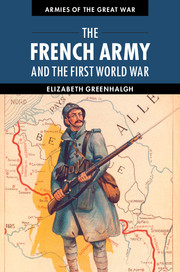Book contents
- Frontmatter
- Contents
- List of figures
- List of maps
- List of tables
- Preface
- List of abbreviations
- Introduction
- 1 The pre-war Army
- 2 1914: From the frontiers to Flanders
- 3 1915: On the offensive
- 4 1916: Verdun and the Somme
- 5 General Nivelle and his 1917 offensive
- 6 Restoring the Army
- 7 1918: German offensives
- 8 The path to victory
- 9 Armistices and demobilisation
- 10 From 1914 to 1919: Aux armes, citoyens!
- Notes
- Bibliographic essay
- Index
8 - The path to victory
Published online by Cambridge University Press: 05 November 2014
- Frontmatter
- Contents
- List of figures
- List of maps
- List of tables
- Preface
- List of abbreviations
- Introduction
- 1 The pre-war Army
- 2 1914: From the frontiers to Flanders
- 3 1915: On the offensive
- 4 1916: Verdun and the Somme
- 5 General Nivelle and his 1917 offensive
- 6 Restoring the Army
- 7 1918: German offensives
- 8 The path to victory
- 9 Armistices and demobilisation
- 10 From 1914 to 1919: Aux armes, citoyens!
- Notes
- Bibliographic essay
- Index
Summary
Foch had decided to unify the defensive and offensive battles. Even before Marneschutz began, he was planning the counter-offensive. Mangin’s small-scale counter-attack after Germany’s June offensive on the Matz had shown that the French Army was still capable of winning a victory. Despite the ‘surprise’ on the Chemin des Dames in May, Foch had confidence in French intelligence reports, and he was seeing GQG’s head of intelligence, Colonel Cointet, regularly. On 17 July Ludendorff was told that it would take several days before operations could re-start to cut off Reims, which town’s railway station was still badly needed, and then he set off for Rupprecht’s headquarters to continue the planning for Operation Hagen against the British lines. By the evening, however, the German lines were in a state of chaos and the Seventh Army units south of the river were ordered to return to the north bank as French artillery and aircraft fire was destroying almost all the pontoon bridges. Now the French Army was ready to retaliate.
The 18 July counter-attack
Mangin believed that conditions around Soissons were favourable for a counter-attack, and on 8 July Pétain approved his proposal as a good riposte to the expected German attack. Mangin had taken over command of Tenth Army on 10 June and two of his five army corps (XX and XXX Corps) had been making small local gains ever since along his east-facing front between the Oise and the Savières, a small tributary of the Ourcq. These advances gave excellent jumping-off positions north and south of the heavily wooded forest of Villers-Cotterêts, which would provide equally excellent cover. A surprise attack was, therefore, perfectly possible. Mangin was confident that these successful local attacks proved his troops capable of bigger things, for the numbers of prisoners captured during them pointed to a serious diminution of the enemy’s offensive capability. His army group commander, Fayolle, endorsed Mangin’s views, while warning that the infantry and artillery resources that Mangin was demanding would be dependent upon availability after the German offensive.
- Type
- Chapter
- Information
- The French Army and the First World War , pp. 312 - 344Publisher: Cambridge University PressPrint publication year: 2014



